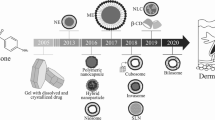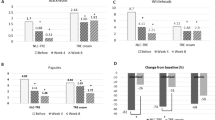Abstract
Purpose
Topical cyproterone acetate (CPA) treatment of skin diseases should reduce side effects currently excluding the use in males and demanding contraceptive measures in females. To improve skin penetration of the poorly absorbed drug, we intended to identify the active moiety and to load it to particulate carrier systems.
Materials and Methods
CPA metabolism in human fibroblasts, keratinocytes and a sebocyte cell line as well as androgen receptor affinity of native CPA and the hydrolysis product cyproterone were determined. CPA 0.05% loaded solid lipid nanoparticles (SLN), nanostructured lipid carriers (NLC), a nanoemulsion and micropheres were characterized for drug-particle interaction and CPA absorption using human skin ex-vivo.
Results
Native CPA proved to be the active agent. Application of CPA attached to SLN increased skin penetration at least four-fold over the uptake from cream and nanoemulsion. Incorporation into the lipid matrix of NLC and microspheres resulted in a 2–3-fold increase in CPA absorption. Drug amounts within the dermis were low with all preparations. No difference was seen in the penetration into intact and stripped skin.
Conclusion
With particulate systems topical CPA treatment may be an additional therapeutic option for acne and other diseases of the pilosebaceous unit.





Similar content being viewed by others
Abbreviations
- BSA:
-
bovine serum albumin
- CP:
-
cyproterone
- CPA:
-
cyproterone acetate
- DHT:
-
dihydrotestosterone
- EC50 :
-
concentration of drug specifically deplacing 3H-DHT by 50%
- EDTA:
-
ethylenediamine tetraacetic acid
- FCS:
-
fetal calf serum
- GAPDH:
-
glyceraldehyde 3-phosphate dehydrogenase
- GR+/29+:
-
mouse fibroblasts cell line GR+/29+
- LD95%:
-
maximum particles size of 95% of the particles
- mRNA:
-
messenger-RNA
- MS:
-
microspheres
- MTT:
-
3-(4,5-dimethylthiazol-2-yl)-2,5-diphenyltetrazolium bromide
- NLC:
-
nanostructured lipid carrier(s); M (Miglyol® 812), O (oleic acid) added as indicated to the lipid component
- NE:
-
nanoemulsion
- PBS:
-
phosphate-buffered saline
- PCR:
-
polymerase chain reaction
- PCS:
-
photon correlation spectroscopy
- PI:
-
polydispersity index
- PS:
-
parelectric spectroscopy
- rph:
-
rotation per hour
- SD:
-
standard deviation
- SLN:
-
solid lipid nanoparticle
- SZ95:
-
immortalised sebocyte line
- f0 :
-
dipole mobility
- Δɛ:
-
dipole density
- \(\overline{{\text{x}}}\) :
-
arithmetic mean value
References
W. F. Bergfeld. The evaluation and management of acne: economic considerations. J. Am. Acad. Dermatol. 32:S52–S56 (1995).
H. Akamatsu, C. C. Zouboulis, and C. E. Orfanos. Control of human sebocyte proliferation in vitro by testosterone and 5-alpha-dihydrotestosterone is dependent on the localization of the sebaceous glands. J. Invest. Dermatol. 99:509–511 (1992).
M. Fritsch, C. E. Orfanos, and C. C. Zouboulis. Sebocytes are the key regulators of androgen homeostasis in human skin. J. Invest. Dermatol. 116:793–800 (2001).
Y. Ando, Y. Yamaguchi, K. Hamada, K. Yoshikawa, and S. Itami. Expression of mRNA for androgen receptor, 5alpha-reductase and 17beta-hydroxysteroid dehydrogenase in human dermal papilla cells. Br. J. Dermatol. 141:840–845 (1999).
D. Van Neste. Natural scalp hair regression in preclinical stages of male androgenetic alopecia and its reversal by finasteride. Skin Pharmacol. Physiol. 19:168–176 (2006).
D. Van Neste, V. Fuh, P. Sanchez-Pedreno, E. Lopez-Bran, H. Wolff, D. Whiting, J. Roberts, D. Kopera, J. J. Stene, S. Calvieri, A. Tosti, E. Prens, M. Guarrera, P. Kanojia, W. He, and K. D. Kaufman. Finasteride increases anagen hair in men with androgenetic alopecia. Br. J. Dermatol. 143:804–810 (2000).
W. A. van Vloten, C. W. van Haselen, E. J. van Zuuren, C. Gerlinger, and R. Heithecker. The effect of 2 combined oral contraceptives containing either drospirenone or cyproterone acetate on acne and seborrhea. Cutis 69:2–15 (2002).
C. C. Zouboulis. Therapie der Akne mit Antiandrogenen—Eine evidenzbasierte Übersicht. J. Dtsch. Dermatol. Ges. 1:535–546 (2003).
J. Fiet, R. Morville, D. Chemama, J. M. Villette, B. Gourmel, J. L. Brerault, and C. Dreux. Percutaneous absorption of 5 alpha-dihydrotestosterone in man. I. Plasma androgen and gonadotrophin levels in normal adult men after percutaneous administration of 5 alpha-dihydrotestosterone. Int. J. Androl. 5:586–594 (1982).
R. T. Scott, Jr., B. Ross, C. Anderson, and D. F. Archer. Pharmacokinetics of percutaneous estradiol: a crossover study using a gel and a transdermal system in comparison with oral micronized estradiol. Obstet. Gynecol. 77:758–764 (1991).
F. Iraji, A. Momeni, S. M. Naji, and A. H. Siadat. The efficacy of topical cyproterone acetate alcohol lotion versus placebo in the treatment of the mild to moderate acne vulgaris: a double blind study. Dermatol. Online J. 12:26 (2006).
M. J. Choi and H. I. Maibach. Liposomes and niosomes as topical drug delivery systems. Skin Pharmacol. Physiol. 18:209–219 (2005).
M. Schäfer-Korting, W. Mehnert, and H. C. Korting. Lipid nanoparticles for improved topical application of drugs for skin diseases. Adv. Drug Deliv. Rev. (in press).
E. Bernard, J. L. Dubois, and J. Wepierre. Importance of sebaceous glands in cutaneous penetration of an antiandrogen: target effect of liposomes. J. Pharm. Sci. 86:573–578 (1997).
D. M. Gruber, M. O. Sator, E. A. Joura, E. M. Kokoschka, G. Heinze, and J. C. Huber. Topical cyproterone acetate treatment in women with acne: a placebo-controlled trial. Arch. Dermatol. 134:459–463 (1998).
U. Münster, C. Nakamura, A. Haberland, K. Jores, W. Mehnert, S. Rummel, M. Schaller, H. C. Korting, C. Zouboulis, U. Blume-Peytavi, and M. Schäfer-Korting. RU 58841-myristate-prodrug development for topical treatment of acne and androgenetic alopecia. Pharmazie 60:8–12 (2005).
G. Cevc. Lipid vesicles and other colloids as drug carriers on the skin. Adv. Drug Deliv. Rev. 56:675–711 (2004).
A. A. Date, B. Naik, and M. S. Nagarsenker. Novel drug delivery systems: potential in improving topical delivery of antiacne agents. Skin Pharmacol. Physiol. 19:2–16 (2006).
C. Freitas and R. H. Müller. Stability determination of solid lipid nanoparticles (SLN) in aqueous dispersion after addition of electrolyte. J Microencapsul. 16:59–71 (1999).
V. Jenning, A. F. Thunemann, and S. H. Gohla. Characterisation of a novel solid lipid nanoparticle carrier system based on binary mixtures of liquid and solid lipids. Int. J. Pharm. 199:167–177 (2000).
B. Siekmann and K. Westesen. Sub-micron sized parenteral carrier systems based on solid lipid. Pharm. Pharmacol. Lett. 1:123–126 (1992).
A. zur Mühlen, C. Schwarz, and W. Mehnert. Solid lipid nanoparticles (SLN) for controlled drug delivery-drug release and release mechanism. Eur. J. Pharm. Biopharm. 45:149–155 (1998).
R. H. Müller, M. Radtke, and S. A. Wissing. Solid lipid nanoparticles (SLN) and nanostructured lipid carriers (NLC) in cosmetic and dermatological preparations. Adv. Drug Deliv. Rev. 54(Suppl 1):S131–S155 (2002).
S. Lombardi-Borgia, M. Regehly, R. Sivaramakrishnan, W. Mehnert, H. C. Korting, K. Danker, B. Röder, K. D. Kramer, and M. Schäfer-Korting. Lipid nanoparticles for skin penetration enhancement-correlation to drug localization within the particle matrix as determined by fluorescence and parelectric spectroscopy. J. Control. Release 110:151–163 (2005).
C. Santos Maia, W. Mehnert, M. Schaller, H. Korting, A. Gysler, A. Haberland, and M. Schäfer-Korting. Drug targeting by solid lipid nanoparticles for dermal use. J. Drug Target. 10:489–495 (2002).
R. Sivaramakrishnan, C. Nakamura, W. Mehnert, H. C. Korting, K. D. Kramer, and M. Schäfer-Korting. Glucocorticoid entrapment into lipid carriers-characterisation by parelectric spectroscopy and influence on dermal uptake. J. Control. Release 97:493–502 (2004).
R. M. Hoffman. Topical liposome targeting of dyes, melanins, genes, and proteins selectively to hair follicles. J. Drug Target. 5:67–74 (1998).
J. Lademann, H. Weigmann, C. Rickmeyer, H. Barthelmes, H. Schaefer, G. Mueller, and W. Sterry. Penetration of titanium dioxide microparticles in a sunscreen formulation into the horny layer and the follicular orifice. Skin Pharmacol. Appl. Skin Physiol. 12:247–256 (1999).
R. Toll, U. Jacobi, H. Richter, J. Lademann, H. Schaefer, and U. Blume-Peytavi. Penetration profile of microspheres in follicular targeting of terminal hair follicles. J. Invest. Dermatol. 123:168–176 (2004).
A. Gysler, B. Kleuser, W. Sippl, K. Lange, H. C. Korting, H. D. Höltje, and M. Schäfer-Korting. Skin penetration and metabolism of topical glucocorticoids in reconstructed epidermis and in excised human skin. Pharm. Res. 16:1386–1391 (1999).
A. Gysler, K. Lange, H. C. Korting, and M. Schäfer-Korting. Prednicarbate biotransformation in human foreskin keratinocytes and fibroblasts. Pharm. Res. 14:793–797 (1997).
M. M. Bouton, D. Lecaque, J. Secchi, and C. Tournemine. Effect of a new topically active antiandrogen (RU 38882) on the rat sebaceous gland: comparison with cyproterone acetate. J. Invest. Dermatol. 86:163–167 (1986).
C. Luderschmidt, J. Jawny, and W. Eiermann. Relative binding affinity at metribolone androgenic binding sites of various antiandrogenic agents. Arzneimittelforschung 37:1262–1265 (1987).
C. C. Zouboulis, H. Seltmann, H. Neitzel, and C. E. Orfanos. Establishment and characterization of an immortalized human sebaceous gland cell line (SZ95). J. Invest. Dermatol. 113:1011–1020 (1999).
K. Lange, B. Kleuser, A. Gysler, M. Bader, C. Maia, C. Scheidereit, H. C. Korting, and M. Schäfer-Korting. Cutaneous inflammation and proliferation in vitro: differential effects and mode of action of topical glucocorticoids. Skin Pharmacol. Appl. Skin Physiol. 13:93–103 (2000).
H. J. List, C. Lozano, J. Lu, M. Danielsen, A. Wellstein, and A. T. Riegel. Comparison of chromatin remodeling and transcriptional activation of the mouse mammary tumor virus promoter by the androgen and glucocorticoid receptor. Exp. Cell Res. 250:414–422 (1999).
E. Makrantonaki, J. Adjaye, R. Herwig, T. C. Brink, D. Groth, C. Hultschig, H. Lehrach, and C. C. Zouboulis. Age-specific hormonal decline is accompanied by transcriptional changes in human sebocytes in vitro. Aging Cell 5:331–344 (2006).
W. Mehnert and K. Mäder. Solid lipid nanoparticles: production, characterization and applications. Adv. Drug Deliv. Rev. 47:165–196 (2001).
S. Schreiber, A. Mahmoud, A. Vuia, M. K. Rübbelke, E. Schmidt, M. Schaller, H. Kandarova, A. Haberland, U. F. Schäfer, U. Bock, H. C. Korting, M. Liebsch, and M. Schäfer-Korting. Reconstructed epidermis versus human and animal skin in skin absorption studies. Toxicol. In Vitro 19:813–822 (2005).
U. Jacobi, H. J. Weigmann, M. Baumann, A. I. Reiche, W. Sterry, and J. Lademann. Lateral spreading of topically applied UV filter substances investigated by tape stripping. Skin Pharmacol. Physiol. 17:17–22 (2004).
S. Inui, S. Itami, H. J. Pan, and C. Chang. Lack of androgen receptor transcriptional activity in human keratinocytes. J. Dermatol. Sci. 23:87–92 (2000).
R. Alvarez-Roman, A. Naik, Y. N. Kalia, R. H. Guy, and H. Fessi. Enhancement of topical delivery from biodegradable nanoparticles. Pharm. Res. 21:1818–1825 (2004).
I. M. Schneider, W. Wohlrab, and R. Neubert. Fettsäuren und Epidermis. Hautarzt 48:303–310 (1997).
S. J. Bashir, A. L. Chew, A. Anigbogu, F. Dreher, and H. I. Maibach. Physical and physiological effects of stratum corneum tape stripping. Skin Res. Technol. 7:40–48 (2001).
H. Weigmann, J. Lademann, H. Meffert, H. Schaefer, and W. Sterry. Determination of the horny layer profile by tape stripping in combination with optical spectroscopy in the visible range as a prerequisite to quantify percutaneous absorption. Skin Pharmacol. Appl. Skin Physiol. 12:34–45 (1999).
Acknowledgement
Financial support of the Deutsche Forschungsgemeinschaft, FG 463 (SCHA 382, KR 1696), is gratefully acknowledged.
Author information
Authors and Affiliations
Corresponding author
Rights and permissions
About this article
Cite this article
Štecová, J., Mehnert, W., Blaschke, T. et al. Cyproterone Acetate Loading to Lipid Nanoparticles for Topical Acne Treatment: Particle Characterisation and Skin Uptake. Pharm Res 24, 991–1000 (2007). https://doi.org/10.1007/s11095-006-9225-9
Received:
Accepted:
Published:
Issue Date:
DOI: https://doi.org/10.1007/s11095-006-9225-9




